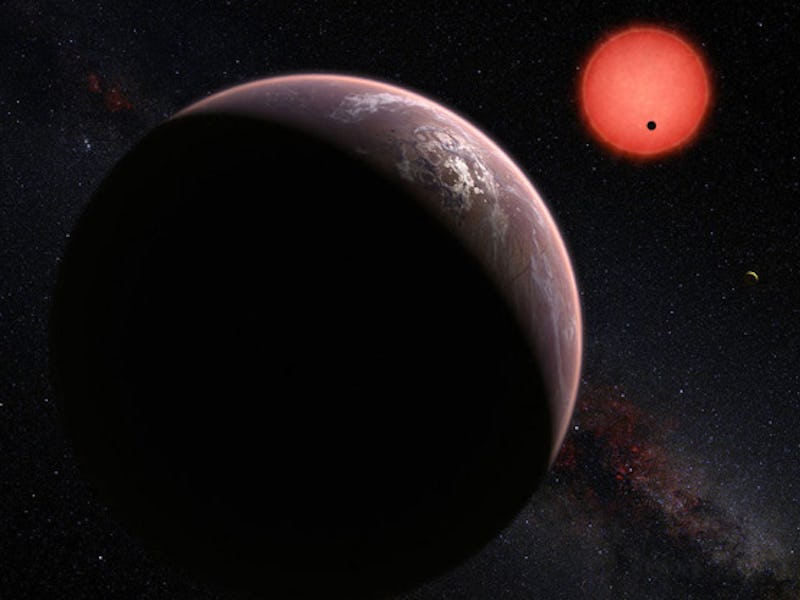Two Ancient Earth-Size Planets Discovered in a Nearby Star's "Goldilocks Zone"
It might be 12.5 light years away, but in cosmological terms, that's just down the street

Astronomers announced this week that they’ve found two planets nearly identical in mass to that of Earth, within the habitable zone of a star that, cosmologically speaking, is not very far away at all.
Being in the habitable zone – sometimes referred to as the “Goldilocks Zone”– mean it’s not so close to the star that water just boils away, or too far so that everything’s frozen, but in the middle, where it’s just right. In other words, water could theoretically exist on the surface in a liquid state, just like our oceans.
The star is called Teegarden’s star and it is only 12.5 light years away, making it the 24th closest star to the Sun. It’s a very low-mass star, what’s known as a red dwarf, which means it’s close to the lowest mass it possibly can be and still be a star.
Its diameter is about 1/10th of the Sun’s, its mass is just 8.9 percent of the Sun’s, and it shines at a paltry 0.00073 times the Sun’s luminosity. That makes it very faint in our night sky – about 15th magnitude, meaning you’d need a pretty good telescope to be able to see it at all – which is why is wasn’t discovered until 2003.
The planets are actually pretty close to the star, but that’s alright because it’s not super hot. Its temperature is something like 2,380 to 2,630°C compared to the Sun, which is 5,500°C.
Yeah...different kind of red dwarf
The planets were found using an instrument called Calar Alto high-Resolution search for M dwarfs with Exoearths with Near-infrared and optical Échelle Spectrographs…or just CARMENES for short. It’s an extremely sensitive detector mounted on a telescope at the Calar Alto observatory in southern Spain that looks for new, alien worlds that might be similar to Earth orbiting very cool red dwarfs.
Scientists estimate that Teegarden’s star is at least eight billion years old, or nearly twice the age of our Sun. That means any planets orbiting it are nearly as ancient; Earth is a baby in comparison, at just 4.5 billion years old. Imagine a civilization that’s had twice as long to evolve…and presumably didn’t destroy itself fighting over small, green pieces of paper.
But it’s necessary to remember that the announcement, which appeared in the journal Astronomy & Astrophysics, says that they are Earth-sized, not Earth-like, and this is an important distinction to make.
"This doesn’t necessarily rule out forms of complex life with specific adaptations to those extreme conditions"
Only this week, a different study by researchers at the University of California suggested that while we focus on if the planet is in the habitable zone and if it can it support liquid water at surface temperature, there’s another matter to consider, now that the technology used to detect these planets has improved: Does the planet have a toxic atmosphere?
Edward Schwieterman, the lead author of that study on toxic atmospheres on exoplanets in a habitable zone, spoke to Inverse about the discovery of the two Earth-sized planets.
“It’s certainly a very exciting discovery,” Schwieterman says. “At the very least, these newly discovered planets around Teegarden’s Star would be great places to search for microbial life. However, if we placed Earth in the same position of these planets around Teegarden’s Star, which is much cooler and redder than our Sun, our atmosphere would become toxic for humans and higher animals.”
Still though, Schwieterman says the newly discovered planets may be good locations to look for alien life.
“This doesn’t necessarily rule out forms of complex life with specific adaptations to those extreme conditions, but I would not bet on humans being able to breathe the atmospheres on these worlds.
“Ultimately, we should robustly test all of these predictions with future observations,” Schwieterman says.
An illustration that shows Teegarden's star and the likely orbits of its two newfound planets (image: © Andreas Hougardy/University of Göttingen)
The inner planet, called Teegarden b, has an orbit that lasts just 4.9 days, which means its year is less than one of our Earth weeks. It’s a circular orbit and the planet is about 3.8 million km from the star. Compare that to Mercury, which orbits the Sun at about 60 million km.
The second planet, Teegarden c, orbits the star every 11.4 days at a distance of 6.6 million km and both planets are between 1.1 and 1.25 times the mass of Earth.
Given all of these facts, astronomers have calculated that Teegarden b gets about 1.15 times the energy from its star that Earth does from the Sun, while planet c gets about 0.37 and that puts both of them in the habitable zone.
So while this news is really very exciting, it’s worth noting that, technically-speaking, both Venus and Mars are in the Sun’s habitable zone and there’s no way either of those can support any life, complex or otherwise.